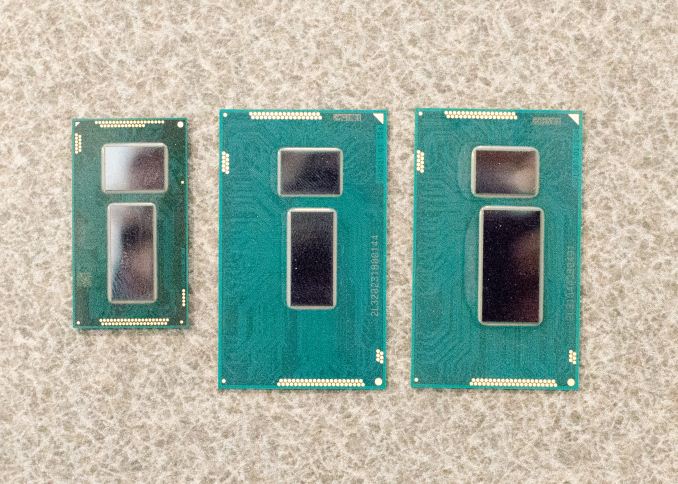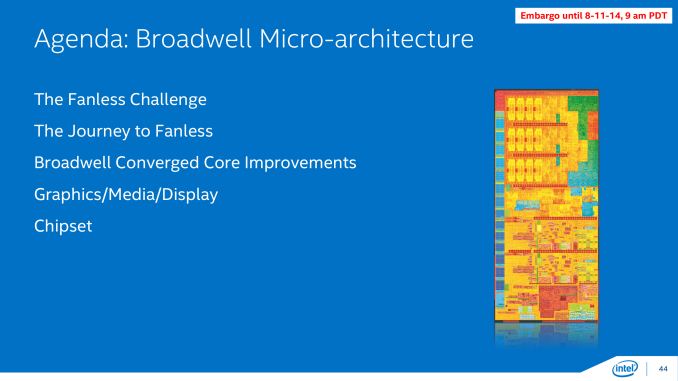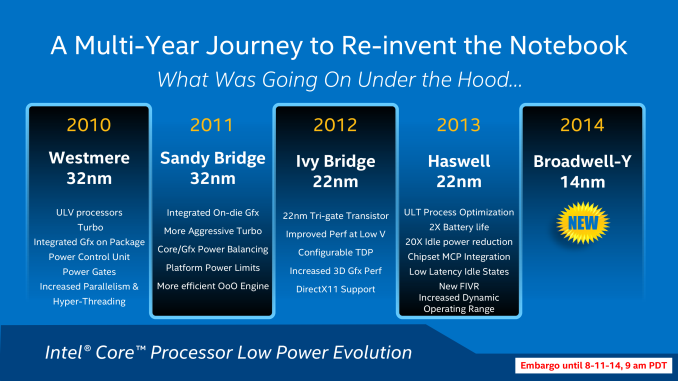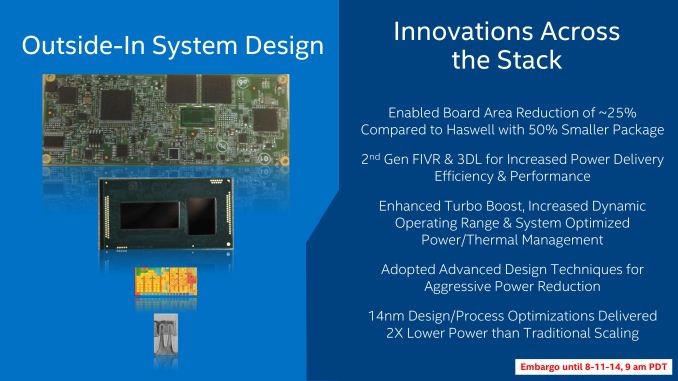Intel Broadwell Architecture Preview: A Glimpse into Core M
by Ryan Smith on August 11, 2014 12:01 PM EST
With Haswell Refresh fully behind us and 2014 now in to its second half, Intel is turning their attention to their next generation of products and processes. Intel’s tick-tock methodology coupled with the long development periods of new products means that the company has several projects in flight at any given time. So while we have seen the name Broadwell on Intel’s roadmaps for some time now, the reality of the situation is that we know relatively little about Intel’s next generation architecture and the 14nm process that it is the launch vehicle for.
Typically we would see Intel unveil the bulk of the technical details of their forthcoming products at their annual Intel Developer Forum, and with the next IDF scheduled for the week of September 9th we’ll see just that. However today Intel will be breaking from their established standards a bit by not waiting until IDF to deliver everything at once. In a presentation coinciding with today’s embargo, dubbed Advancing Moore’s Law in 2014, Intel will be offering a preview of sorts for Broadwell while detailing their 14nm process.
Today’s preview and Intel’s associated presentation are going to be based around the forthcoming Intel Core M microprocessor, using the Broadwell configuration otherwise known at Broadwell-Y. The reason for this is a culmination of several factors, and in all honesty it’s probably driven as much by investor relations as it is consumer/enthusiast relations, as Intel would like to convince consumer and investor alike that they are on the right path to take control of the mobile/tablet market through superior products, superior technology, and superior manufacturing. Hence today’s preview will be focused on the part and the market Intel feels is the most competitive and most at risk for the next cycle: the mobile market that Core M will be competing in.
To that end Intel’s preview is very much a preview; we will see bits and pieces of Broadwell’s CPU architecture, GPU architecture, and packaging, along with information about Intel’s 14nm process. However this isn’t a full architecture preview or a full process breakdown. Both of those will have to wait for Intel’s usual forum of IDF.
Diving into matters then, Core M will be launch vehicle for Broadwell and will be released for the holiday period this year. In fact Intel is already in volume production of the Broadwell-Y CPU and production units are shipping to Intel’s customers (the OEMs) to begin production and stockpiling of finished devices for the holiday launch.
Intel’s decision to initially focus Broadwell on the mobile market comes as the company takes the next step in their plan to extend into the Core processor series into these devices. Arguably, Intel has been slow to response to the rise of ARM devices, whose rapid rise has undercut traditional PC sales and quickly become the biggest threat to Intel’s processor dominance in some number of years. Intel is far from doomed right now, but even they see the potential farther down the line if they do not act.
Intel for their part has responded, but it has taken a step-by-step (multi-year) process that has seen the company progressively build smaller and less power hungry CPUs in order to fit the needs of the mobile market. Since Intel integrated their graphics on-die with Sandy Bridge in 2011, the company has continued to tweak the designs of their products, with Ivy Bridge and Haswell generation products introducing further optimizations and new manufacturing processes. Now on their latest iteration with Broadwell, the company believes they’re turning a corner and have the technology they need to be a leader in the high performance mobile market. It's important to note that despite Intel's best intentions here, Broadwell and Core M remain targeted at premium devices. You won't see these parts in cheap tablets. The duty of doing battle with ARM remains Atom's alone.
Many of these changes ultimately amount to boosting performance and reducing power consumption to a point where power and heat are where they need to be for mobile form factors, either through process efficiency improvements or through better power management and wider dynamic ranges – boosting where it matters and doing a better job of idling between tasks. However as Intel has discovered they not only need to be able to meet the TDP requirements of a tablet but they need to be able to meet the size requirements too. A particularly daunting task when the entire thickness of a device needs to be under 10mm, and the CPU thinner yet.
As a result, coupled with Core M’s performance improvements and power reductions is a strong emphasis on the size of the processor package itself and what Intel could do to reduce it. Intel calls this an outside-in system design, with various parts of Intel focusing on everything from the size of the logic board needed to hold the processor to the thickness of the processor die itself. In the following pages we’ll take a look at Intel’s efforts to get slim, but to kick things off we have a picture of Broadwell-Y from Computex 2014.

From left to right: Broadwell-Y (Core M), Broadwell ULT/ULX and Haswell ULT/ULX
Intel wants a greater foothold in the mobile market and they want it badly. And with Broadwell-Y they believe they finally have what they need to accomplish that goal.














158 Comments
View All Comments
AnnonymousCoward - Tuesday, August 12, 2014 - link
You should look at discrete graphics HW sales.tuxRoller - Tuesday, August 12, 2014 - link
Nvidia, which has around 60% of the discrete gpu market, has a yearly revenue of around $4 000 000 000. So, you're looking at a total market of around $7 000 000 000.Johnmcl7 - Tuesday, August 12, 2014 - link
"Maybe not obsess, but to characterise the PC gaming market as ridiculously small, is pretty far off the mark...."I think the original comment was fairly accurate, even in the PC gaming market there's a large proportion of people using Intel graphics cards. Looking at the current Steam survey results, 75% are using Intel processors and 20% overall are using Intel graphics which means around 1 in 3 people with Intel processors on Steam are using the onboard graphics card. The means even among the gaming market there's a lot of integrated cards in use and that's just one small portion as I'd expect most other areas to mainly be using integrated cards.
There are workstation graphics cards but professionals using those are unlikely to be using consumer processors and the enthusiast/workstation processors do not have an integrated graphics card.
zepi - Tuesday, August 12, 2014 - link
I have had steam on my company laptop with just internal GPU just to take part into the sales campains etc. This makes my contribution to 50:50 in terms on dGPU / iGPU, even though 100% of gaming happens with dGPU.AnnonymousCoward - Tuesday, August 12, 2014 - link
So....how do NVIDIA and ATI stay in business? Obviously many people use discrete cards. The fact you say "obsess" tells me you probably don't realize the massive performance difference, and it's not limited to gaming. CAD uses 3D.AnnonymousCoward - Wednesday, August 13, 2014 - link
Doesn't Intel make X-version CPUs that can be overclocked? The OC market is gonna be much smaller than dGPU, and they're already making a dedicated product for that.Krysto - Tuesday, August 12, 2014 - link
Because they are using that anti-competitive tactic to drive out the discrete competition. They force OEMs to buy them bundled, so more and more people say "why should I pay twice for the GPU...I'll just get the Intel one".It's a nasty tactic, Intel has been employing for years, and unfortunately it's working. But it's terribly uncompetitive.
Krysto - Tuesday, August 12, 2014 - link
It's akin to Microsoft bundling IE with Windows "Why would I need to get another browser...I'll just use IE". That tactic WORKED for Microsoft. It only stopped working when they became lazy. But they could've hold the 90 percent market share of IE for a lot longer, if they didn't get lazy.AnnonymousCoward - Tuesday, August 12, 2014 - link
I dunno--anyone who plans to get a discrete card is going to get one, regardless of Intel forcing it onto the CPU.I wonder what percent of the desktop die will be GPU. Maybe with the GPU disabled, the CPU turbo will work better since there will be less heat.
name99 - Tuesday, August 12, 2014 - link
"we’ll still have to wait to see just how good the resulting retail products are, but there shouldn’t be any technical reason for why it can’t be put into a mobile device comparable to today’s 10”+ tablets. "There may not be TECHNICAL reasons, but there are very definite economic reasons.
People think of tablets as cheap devices --- iPad at the high end, but the mass market at $350 or so. This CPU alone will probably cost around $300. MS is willing to pay that for Surface Pro 4; no-one else is, not for a product where x86 compatibility is not essential.
We'll see it in ultrabooks (and various ultrabook perversions that bend or slide or pop into some sort of tablet) but we're not going to see a wave of sub<$1000 products using this.